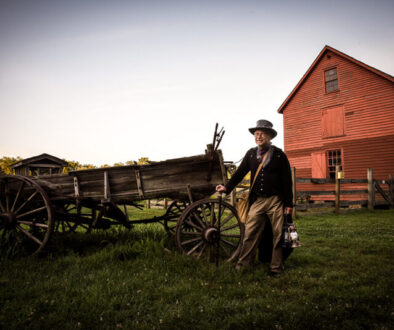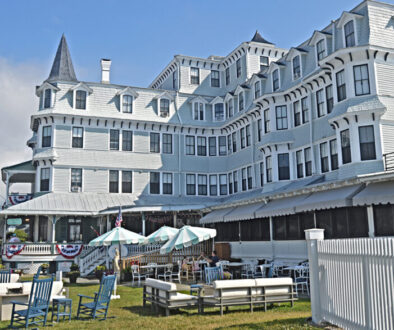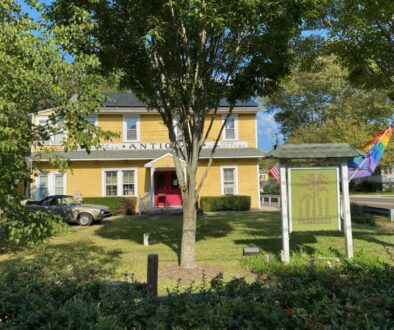Past Tense: Exploring a former Cape May house with a history

The old house is gone now. A victim of demolition. For more than a decade, the former homestead sat sadly by the side of Seashore Road, just south of the Cape May Canal near Seahorse Farm, deteriorating, rotting—awaiting any hope of salvation. But decades of apathy wore away any possibility the building could be saved. Eventually it was too late. So, on July 10, 2000, in a matter of hours, more than a century of American history vanished. To some it didn’t matter—just an old house cluttering an otherwise valuable piece of land. That Civil War hero Colonel Henry Sawyer lived here during the last years of his life seemed just a dusty memory. Others shook their heads, appreciating its history and called it a shame. Such a sad state of affairs. So much history, but too much money to invest.
Henry Sawyer was born Henry Washington Saeger in the farmlands of Pennsylvania. His father, a farmer, wanted him to carry on the family farm. Henry had other ideas, left the farm and never had contact with his father again. He studied carpentry, and in 1848 settled in Cape May, anglicizing his last name to Sawyer, a literal translation—Saeger in German meaning carpenter– feeling Cape May’s heritage would be more receptive. It worked. He married Harriett Ware Eldredge, a Mayflower descendant, who bore his two children.
At first, he worked odd jobs as a carpenter—a shed here and an outhouse there. The day of April 15, 1861 changed his life forever. That was the day President Abraham Lincoln issued a proclamation calling for volunteers in the “War Between the States.” Henry Sawyer was the first man in Cape May County to enlist; he came home from work that day, put his tools in a closet, had something to eat, kissed his wife, and said goodbye.

By February of 1862, he was commissioned as a second lieutenant. By October of the same year, his military conduct considered highly commendable, he was promoted to captain.
On June 9, 1863, Henry was severely wounded in the Battle of Brandy’s Station in Virginia and left for dead. Two Confederate soldiers found him alive and took him prisoner, confining him to the notorious Libby Prison in Richmond, Virginia, known for its extremely bad conditions and treatment of prisoners.
Henry, perhaps optimistically, assumed he would be traded for Confederate prisoners, a common practice between both sides. Unfortunately, two rebel officers had recently been executed, and the Confederacy was screaming for retribution. A lottery was conducted at Libby Prison to choose which two prisoners would be executed in their place. Henry Sawyer’s name was the first drawn from the lottery box. His fate seemed sealed.
Nine long months went by and despite the tortuous conditions he endured, he was championed for his “unfaltering courage, steady and calm” by his inmates. His wife wrote a pleading letter to Washington, D.C, which was given to President Lincoln and the Secretary of State, who immediately directed that two southern generals, both being held as prisoners of war, be exchanged. The strategy worked.
On March 23, 1864, Henry Sawyer arrived in Philadelphia, somewhat weak but in good spirits. When he got to Cape May, he was given a hero’s welcome with a medal of honor and a parade.
In 1875, he built Sawyer’s Boarding House on Howard Street. He changed its name to the Chalfonte Hotel the next year, and it grew into a reputable hotel catering to mostly southern clientele. Henry Sawyer held no grudges against his southern foe. “After the war, where blood once flowed, flowers now grow. We are one people again and the greatest country of the world. All is forgiven,” he wrote.
It was said that every man, woman and child could recite by heart Henry’s “Lottery of Death” story, and he was often seen riding his white stallion through the streets of Cape May.


It was Henry Sawyer who sounded the alarm of Cape May’s most disastrous fire in 1878, which burned 35 acres on the island. Standing in the cupola of the Chalfonte as he did each morning, he noticed smoke pouring from a Washington Street hotel and rang the alarm bell.
There are some people for whom the past is not gone. To them history lives on: vibrant, unending, and sometimes almost tactile.
During the last years of his life, Sawyer lived on a farm on Seashore Road just south of the Cape May Canal with his second wife, Mary Emma, and their son, Henry Sawyer, Jr.
Cape May Court House resident Clark Donlin, now deceased, was an avid Henry Sawyer historian. In fact, he spent years working on a Henry Sawyer biography which, unfortunately, remained unfinished at the time of death. Clark always said he felt “the past come alive” every time he donned a Union blue Civil War uniform as a reenactor.
And Villas resident Gail Farace knows history never really dies—she says she can see it, literally. Gail is a spiritualist and a medium.
Together one October day at the old Sawyer house on Seashore Road, Clark and Gail joined forces: Clark with his plethora of Henry Sawyer knowledge, and Gail with her physic abilities, adamantly insisting she was completely devoid of any historical information about Sawyer—an unlikely pair to say the least.
Through the years, rumors of sightings at the house had persisted. Clark knew a man claiming to have seen Henry himself 27 years ago, standing at the top of the staircase. The man was a 13-year-old boy at the time, and he never forgot the encounter.
So Clark was curious and expectant. He wanted to meet Sawyer. But he was also skeptical. This was his first experience with a medium. How reliable are they? And do ghosts even exist?
The two met in the driveway of the house. Also along for the ride were Leigh Ann Austin, the real estate agent then trying to sell the house, and myself.
As Clark arrived, Gail was already getting the feel of the place.
“There were stables over there,” she said, pointing toward the large unkempt field behind the house.
Clark nodded in agreement.
“And I see outbuildings over there,” Farace continued, pointing slightly to the right. “Servants, maybe?” she questioned. “No,” she answered herself quickly. “The buildings are nicer than that. Not log cabins, but wooden buildings in nice shape.”
Donlin looked confused. “I don’t know about that,” he said. “That’s a new one to me. But it was a large plantation where they grew many crops. Nothing is documented about outbuildings, but I’m sure Sawyer had people living and working here. You may be right.”


Before entering the house, Gail asked if anyone was frightened. She’d come with holy water and a Bible, she explained, in the event anyone was scared or disagreeable souls met. We all said no—just curious.
As Gail entered the house, she told Donlin she was looking for cold spots. And she immediately found one. “Right now I’m just getting the energy. But here,” she said, “Does anyone see it? A little ectoplasm there in the corner? Like a little fog?”
Clark peeked around the corner and agreed. “I see something,” he said. “Not a figure, but a grayish spot. I see it.”
Gail immediately urged me to take a picture, as I was there to write about and photograph the experience. “You might see it in the picture when it comes out,” she said excitedly.
I snapped a photo quickly where Gail pointed, not even looking through the lens. The house was boarded up, and it was hard to see anything. Gail exclaimed, “Oh, you got her good! Oh, my God. You should have seen what she was wearing!”
“It’s a woman,” said Gail.
“Ask her if she’s Mary Emma,” urged Clark.
“It’s a young woman,” she said. “I’d have to say she’s about in her thirties.”
“Mary Emma was the colonel’s second wife,” Clark concurred. “She would have been about thirty at the time of Sawyer’s death.”
Gail looked for her holy water. “I don’t want her to get frightened.”
Clark said Mary Emma was a devout Methodist.
“That’s why I need my holy water,” said Gail. “She’s very modest and shy.”
He agreed, “Yes, she was an extremely mild-mannered, retiring woman.”
“She says her name is Mary. Or Mar…” said Gail. “They come in at such a high level it’s hard to hear them. All I really got is the M.”
“She wants us to follow her,” continued Gail. “She keeps telling me to go here. Go here. So what is here? What is down at this end?”
“The living room,” answered Clark.
The three of us carefully picked our way through the mounds of used and broken restaurant equipment, boards, lighting fixtures, dust, and dirt. “She’s pointing to this door. In here resting, she’s telling me. ‘In here resting.’ What’s resting in here?” Gail asked Clark.
“Well, her husband was buried from right here in this room. The funeral procession came from this room,” said Donlin.
“Ah, okay. That’s what she’s telling me. He’s in here resting.” Clark was obviously shaken. During a telephone interview later in the week, he told me it was ‘highly doubtful’ Gail could have known that. “This is very uncommon knowledge,” said Clark. “Unless she searched through all the microfilms of the Ocean Wave or Star of the Cape newspapers, there’s really no way she could have known.”
Mary led Gail upstairs. On the way up, Gail said Mary was grieving. “She had a child. Did one of these children pass away?” asked Gail. Clark said one of her sons passed away at the age of 28 during the influenza breakout of 1918.
“That grieved her quite a bit,” Clark said. “He was her firstborn. Henry Washington Sawyer the second.”
“That’s what she’s telling me,” said Gail. “One of her children is still here in spirit. There are many, many spirits up here.”
We settled in what was the front master bedroom. “There are many spirits in here,” Gail felt. “So many spirits. Who’s Charles?” Gail used the English version of the name, pronouncing it more like “Chahles.” “Chahles Young,” she said. “Who’s Chahles Young?” Clark didn’t know. He was looking for the colonel.
“I don’t know Charles,” he said. “Maybe he was a subsequent owner.”
She again said, “There are many, many spirits in here. Unfortunately, Henry isn’t here.”
Clark was incredulous. “Henry isn’t here?” he asked.
“I’m not feeling his presence,” Gail replied. Clark’s disappointment showed on his face. “Mary kind of overpowered the whole session by telling me he’s resting,” Gail explained. “What happens when spirits have obligations or are disheartened, they’re stuck here and there’s no way to get back.” Suddenly, Farace said Sawyer had been reincarnated already. “He’s back here on Earth already. That’s why we’re not picking up his spirit,” she told Clark. “He had unfinished business and he popped right back in. Maybe that’s what Chahles was trying to tell me, that he was Sawyer reincarnated. I don’t know,” said Gail.
Clark told her Sawyer was a robust man, surviving seven wounds during the Civil War. “But he died in five minutes,” Clark continued. “He was an extremely ambitious person. Maybe this incarnated business, coming back, he felt that because he died so suddenly of a heart attack, he had unfinished business.” Farace agreed. That could be it.
“That’s it,” she said with certainty. “He did and this is his second reincarnation since.”
She and Donlin figured his reincarnated soul would be approximately 25 years old because of the last ghostly Sawyer sighting 27 years before.
The session ended. As we left the old farmstead, one thing was agreed. Despite its rather dilapidated appearance, effort should be made to preserve the property. Leigh Ann Austin, familiar with historic homes, said that simply clearing out the building would make a remarkable difference. Clark agreed. “Unfortunately, those looking at the property are more visually attracted to the mess and not the structure. I had a builder look at the farm and he felt it was in sound condition.”
Clark saw the past much as he saw the present. “Human nature never changes,” he said. “Human struggles then are no different than those of today. The venues may have changed but the human fight for survival remains the same.”
Clark said properties tell stories of people in another time, and show not only the differences in lifestyle but also the similarities. “If we don’t have an understanding of the past, we no right to have expectations for the future,” he said. “Properties tell stories of people—human struggles that are no different than those of today. Family, income, patriotism, love, brotherhood. These haven’t changed a bit.”
The tour with Gail opened his eyes even wider. “I went in as a skeptic. But now I’m not so sure,” said Clark.“Mary’s correct age, the ‘resting’ room, the grieving of her son—all of this was highly significant and something Gail could not know. It was uncanny, almost bone-chilling.”
Clark said there certainly may be more than meets the eye and aptly asked, “For what footprints does a man truly leave in the sands of time?”
There was talk the Sawyer House could be saved for one dollar if someone was willing to move it. There were those who wanted to save it, so I asked George Rohana, a leading Cape May historical builder, if he and I could take a tour, inspecting the structural soundness of the house. The windows were not boarded, as demolition was soon to begin.
We began downstairs. George checked around the outside and inside of the house. I, however, remained in the living room remembering my day with Clark and Gail. I’m not sure I told George about my adventure, maybe I did, maybe I didn’t. All was going well and George seemed to think the house could be restored with a lot of work but it was salvageable. We climbed the stairs to the second floor and I started feeling like someone was watching us but I never said anything to George. I didn’t want to scare him away.
George needed to check the attic for the roof situation among other things. The floor was littered with numerous 45 records, many of them by well-known artists. George and I started to go through them. The Beatles, Elvis, you name it. Should we take a few home? After all, the house was slated for demolition in days.
And that’s when we both felt it. Someone was watching us and wasn’t at all happy with us being there. George and I looked at each other. “Do you feel that?” we asked at the same time. “I’m getting out of here,” George said heading quickly for the stairway. I was behind him in a flash, heart pounding, both of us tripping over each other on the way down.
If not Henry Sawyer, there were definitely spirits in this house. I agree with Clark Donlin, what footprints does mankind truly leave behind?



